Machaela Erdeljac
Pittsburgh Celebrities Will Join PBT’s Pittsburgh-esque Version of The Nutcracker!
Ten local Pittsburgh celebrities will be special guest stars during Pittsburgh Ballet Theatre’s (PBT) performances of The Nutcracker this year. Each celebrity will make a guest appearance in a walk-on role during the opening prologue and in the entirety of the “Party Scene” during Act l of the classic holiday production.
PBT’s current version of The Nutcracker, choreographed and created by former PBT artistic director, Terrence S. Orr, is the perfect fit for local celebrity appearances due to its special Pittsburgh-centered vibe. The Nutcracker includes more than 13 Pittsburgh connections – from Kennywood, the Kaufmann’s Clock and Shadyside to the Pittsburgh Pirates, Pittsburgh Penguins, Mount Washington, the Aviary and more. The distinctive Pittsburgh feel of this ballet makes it great fun to include Pittsburgh guest stars in walk-on roles – adding to the Pittsburgh flair!
PBT will present the holiday classic at the Benedum Center December 8-28. Tickets are available here.
The Pittsburgh celebrities participating in cameos in The Nutcracker this year include:
*please note that guest star appearances may be subject to change
 Friday, December 8th @ 7:00 p.m.
Friday, December 8th @ 7:00 p.m.
Kym Gable, KDKA-TV News Anchor
You can see Kym Gable on KDKA anchoring the 4:00 and 6:00 o’clock news each day. She also hosts a popular weekly segment called “On A Positive Note,” which highlights uplifting stories, inspiring people and unsung heroes in Pittsburgh. Her work in television and commercials has won her several Emmy Awards and Telly Awards. Kym is an accomplished
freelance producer, speaker, confidence coach and voice actress. As an advocate for those less fortunate and in crisis, Kym’s mission of community outreach is her driving force. She operates the South chapter of the non-profit support organization Inspired Women Paying It Forward, which has given local and national charities more than $600,000 since its inception. Real Estate Investor, Cryptocurrency Miner, Dancer, Singer and Martial Arts Enthusiast – Kym’s motto is “You Can’t Live an Extraordinary Life If You Keep Doing Ordinary Things.”
 Saturday, December 9 @ 7:00 p.m.
Saturday, December 9 @ 7:00 p.m.
Frzy, Musician/Rapper
Harvey “Frzy” Daniels is a 2018 regional Emmy Award winner for his collaboration with WQED on his hip-hop version of “Won’t You Be My Neighbor” and on November 1, 2023, launched his second and third albums titled Popularity and Success. Frzy is a member of the Recording Academy (which bestows the annual Grammy Awards) and is a Governor of the Board for the Philadelphia Chapter of the Recording Academy. The City of Pittsburgh was inspired to officially declare January 11, 2018, as “Frzy Day.” Since then, Frzy has become a 2020 Guinness World Record holder for longest freestyle rap at 31 hours, inspired his own Smiley Face Cookie at Eat ‘N Park and has had a mural created in his likeness by famous muralist, Jeremy Raymer. Frzy also serves on the Board of Directors of The Lindsay Theater all this while being the face of Steve Madden’s “Self Made” Campaign. He has helped to raise more than $ 1 million for charities, and this year helped to increase diversity and inclusion awareness via the successful “Books to Bars” campaign with the Carnegie Library of Pittsburgh. He collaborated on a historic one-night concert with the Pittsburgh Symphony Orchestra at Heinz Hall on November 8, 2023, which was the world premiere of an orchestration of the nationally-known rapper’s new album, Success. Instagram @frzy, TikTok @therapperfrzy, and Facebook OfficialFrzy.
 Sun., December 10 at 4:30 p.m.
Sun., December 10 at 4:30 p.m.
Gisele Barreto Fetterman, Advocate & Former Second Lady of PA
Gisele Barreto Fetterman is an access and equity advocate, a hugger and the former Second Lady of Pennsylvania. Gisele is the founder of Freestore 15104, where surplus and donated goods are received and redistributed to neighbors in need. Freestore 15104 aims to eradicate food and clothing insecurity and has inspired 13 spin-off locations and the birth of 412 Food Rescue. Gisele is the co-founder of 412 Food Rescue, a community-wide effort to end hunger and reduce food waste, and has rescued tens of millions of pounds of food. She is also the co-founder of For Good PGH, a non-profit that works to advocate inclusion and inspire kindness. Its first initiative, Hello Hijab, has received both national and international praise. She is also a firefighter with Rivers Edge 113. Gisele was born in Brazil, and emigrated as a child to the US, living as an undocumented immigrant for over a decade.
 Fri., December 15 at 7:00 p.m.
Fri., December 15 at 7:00 p.m.
Daisy Jade, Pittsburgh Today Live Reporter
Pittsburgh native Daisy Jade is a Film/TV Actress, TV Host and Producer. She is the Host and Co-Producer of Fan N’ATion, an award-winning and Emmy-nominated show on KDKA-TV/CBS Pittsburgh, highlighting Pittsburgh sports fans from all over the world. Daisy also reports for the city’s lifestyle and entertainment show, Pittsburgh Today Live. Additionally, Daisy is the on-air talent for Pittsburgh’s CW (WPCW-TV), representing the station at live events and producing content for their website and social media accounts. She hosts and produces the web show The CW Buzz. Fan N’ation won a Keystone Media Award for Best Regularly Scheduled News or Sports Talk Program in 2022, and has been nominated for a Mid-Atlantic Emmy.
She is a proud member of SAG-AFTRA, appearing in numerous national and regional shows, commercials and industrials since 1999. She is also involved with various film organizations in Pittsburgh, including Women in Film and Media Pittsburgh and the Pittsburgh Film Industry Association (PAFIA). Daisy graduated from the University of Pittsburgh with a Bachelor of Arts degree in Theater Arts and a Film Studies Certificate.
 Sat., December 16 at 2:00 p.m.
Sat., December 16 at 2:00 p.m.
Lindsay Ward, KDKA-TV News Anchor
Lindsay Ward is the Morning Anchor at KDKA-TV. She joined the station in 2019. Lindsay also does feature reporting for which she has won a first-place Keystone Media Award and has been Emmy-nominated for both her anchoring and reporting.
Lindsay is from Indiana County and an IUP graduate where she studied Communications Media and Political Science. She lives in the Pittsburgh area with her husband, Tony, and their two children, Sebastian and Aurora.
 Sat., December 16 at 7:00 p.m.
Sat., December 16 at 7:00 p.m.
Boaz Frankel, KDKA-TV & Yinzer Backstage Series
Boaz Frankel is a writer, filmmaker and gardener based in Pittsburgh, PA. He’s the host and producer of NEXTpittsburgh’s “Yinzer Backstage Pass” series and a correspondent on KDKA’s Pittsburgh Today Live. He lives in Squirrel Hill with his wife Brooke and their very cute terrier mutt, Kip.
 Sun., December 17 at Noon p.m.
Sun., December 17 at Noon p.m.
Kristine Sorensen, KDKA-TV News Anchor
Kristine Sorensen just celebrated 20 years with KDKA-TV and currently anchors KDKA-TV News at 4 and 5 pm. She also produces special reports in partnership with Kidsburgh.org on positive things in the community for kids and families, and she also hosted Pittsburgh Today Live for 11 years.
Kristine has a Master’s Degree in Journalism from Northwestern University and a Bachelor’s Degree in Government with a minor in dance from the College of William and Mary. She has won numerous awards including a Mid-Atlantic Emmy Award for Features Reporting, an Edward R. Murrow journalism award and the Paramount Impact Award for her volunteer work.
Kristine studied dance since she was a child and performed with dance companies for 10 years. She served on Pittsburgh Ballet Theatre’s Board of Directors for ten years and was the dance critic for the Pittsburgh Post-Gazette. She also volunteers her time with the March of Dimes, the Pancreatic Cancer Action Network and Variety the Children’s Charity.
Kristine is married to KDKA Radio host Marty Griffin. They have two daughters, Sophia and Chloe, and a son, Vincent.
 Thurs., December 21 at 7:00 p.m.
Thurs., December 21 at 7:00 p.m.
Scott Blasey, the Clarks
Scott Blasey is the lead singer, songwriter and guitarist for Pittsburgh-based rock band the Clarks. Over their 34-year career the Clarks have performed all over the country, sold more than a million albums and toured with Steely Dan and John Mayer. They performed live on the Late Show with David Letterman, the 2009 NHL Winter Classic and the Jerry Lewis MDA Labor Day Telethon. Their music has been featured in movies and television shows, including the 2015 season premiere of The Simpsons.
In addition to his success with the band, Scott has found an audience as a solo artist. He’s released three albums and has opened shows for rock icons Neil Young and the Beach Boys. In 2004 Scott received the Distinguished Alumni Award for Service from Indiana University of Pennsylvania, and in 2020 he was inducted into the Connellsville Area High School Hall of Fame. Scott continues to perform with the Clarks, and his “Songs and Stories” shows draw rave reviews and keep him busy as a solo performer.
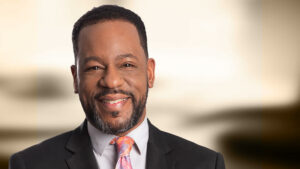 Fri., December 22 at 7:00 p.m.
Fri., December 22 at 7:00 p.m.
Ron Smiley, KDKA-TV Meteorologist
Ron is the meteorologist and contributor on Pittsburgh Today Live on weekday mornings. Since June 2015, Ron has been giving a local and hopefully bright outlook on the day in Pittsburgh and Western Pennsylvania.
Born a Texan, Ron grew up in Little Rock, Arkansas, after his dad retired from the Air Force. After graduating from Little Rock Catholic High, Ron pursued his degree at Arkansas Tech University. He has two daughters.
Before arriving in Pittsburgh, Ron worked in Mississippi and Arkansas, along with most recently, New Orleans and Indianapolis. He says that his love for the weather developed at a young age as he loved to hang out in the garden and talk clouds with his neighbor, Mr. Mike, an employee at the National Weather Service. Ron is a member of the American Meteorological Society and has been rewarded his AMS seal.
In Ron’s free time, he loves to cook and explore with his family. You may catch him out and about on a Saturday morning running for a good cause or hanging with his family at a local park or museum.
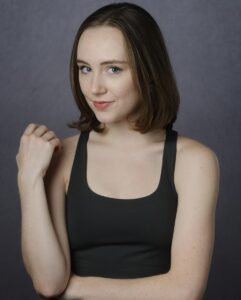 Sat., December 23 at 7:00 p.m.
Sat., December 23 at 7:00 p.m.
Kyra Laubacher, Dance Media, Digital Editor
A proud Pittsburgh native, Kyra is the digital editor for Dance Magazine, Pointe and The Dance Edit with Dance Media Publications. She is a member of Phi Beta Kappa and graduated summa cum laude from Butler University in 2020 with a BFA in Dance Performance and a BA in English Literature. Following graduation, she danced with Eugene Ballet in Eugene, Oregon, and served as a contributing writer for Pointe prior to joining the magazine’s editorial staff in May 2022.
The Nutcracker Casting is Here!
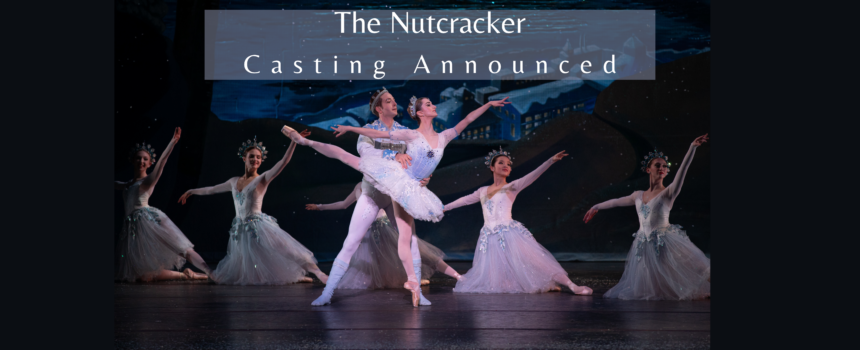

The most magical time of the year is coming soon with PBT’s The Nutcracker! Performances will take place Dec. 8-28 at the Benedum Center in Pittsburgh. Join Marie, her Nutcracker prince and hundreds of colorful characters for an unforgettable adventure through the Land of Enchantment. Create a new tradition with your family and friends while enjoying the stunning scenes, spectacular costumes, sparkling snowflakes and instantly recognizable Tchaikovsky score. All of the roles are performed by the talented artists of Pittsburgh Ballet Theatre and Pittsburgh Ballet Theatre School.
View Casting by Week
*Please note: Casting is subject to change
Banner Image: Jessica McCann & Lucius Kirst | Photo: Rosalie O’Connor
Putting Pittsburgh in The Nutcracker
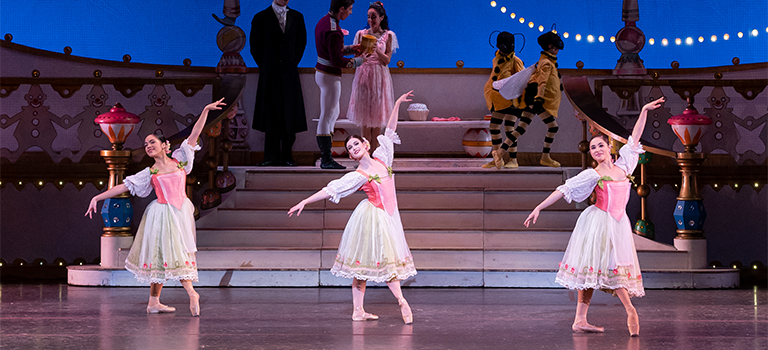
The Nutcracker has enchanted audiences for over 130 years, telling the story of young Marie (renamed to match the original story) and her journey to a mystical land with her heroic nutcracker. There are hundreds of different versions of The Nutcracker performed all around the world. How does Pittsburgh Ballet Theatre set its Nutcracker apart?
Pittsburgh Ballet Theatre makes its current version of the beloved classic uniquely Pittsburgh-connected by including more than 13 different “easter eggs” that only a true “yinzer” might catch. In 2002, former artistic director Terrence S. Orr conceived and choreographed this Pittsburgh-themed version of The Nutcracker and the company has performed this version each year since. Have you noticed any of these “easter eggs” before while watching PBT’s The Nutcracker?
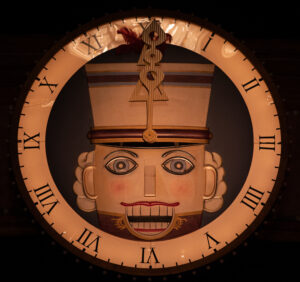
1. Kaufmann’s Clock
Founded in the 1870s in downtown Pittsburgh, Kaufmann’s department store eventually expanded to nearly 60 locations across multiple states until it was bought by Macy’s. Today the original flagship building is left standing along with the iconic Kaufmann’s Clock, both deemed Historical Landmarks. Installed in 1913, the giant ornate timepiece has been known to be a meeting place for Pittsburghers for over 100 years. Spot PBT’s homage clock hanging above the proscenium arch.
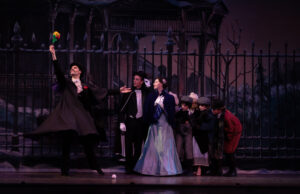
2. F.W. McKee Mansion
Marie Stahlbaum’s family home, where the opening party scene takes place, is a mansion modeled after the old F.W. McKee Mansion. On Fifth Avenue in Shadyside, this stately home was owned by the prominent McKee family, known for glass-manufacturing. The manor has since been torn down, but its memory lives on in PBT’s The Nutcracker.
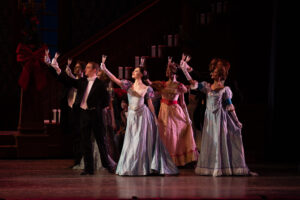
3. The Kaufmann, Grandview, and Heinz party guests
Aside from the hosting Stahlbaum family, PBT has invited three other families of note to the party, The Kaufmanns (owners of Kaufmann’s Department Store), The Grandviews (named for the avenue on Mt. Washington), and the Heinzes (founders of the H. J. Heinz Company). All three names hold a special place in Pittsburgh’s history.

4. Mr. McTavish and the Carnegie family plaid
Another important guest is Mr. McTavish, representing the famous Scottish Pittsburgher, Andrew Carnegie. In his appearance in the party scene, Mr. McTavish wears a kilt of the official Carnegie family plaid, a pattern PBT received express permission from the Carnegie family to use.
5. H. J. Heinz Company Logo
Not only is the Heinz family represented by party guests, but the H. J. Heinz Company Logo can be spotted on Drosselmeyer’s wagon in the opening scene
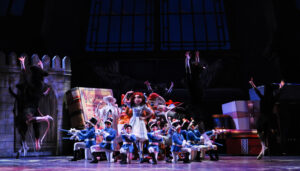
6. Kaufmann’s Christmas Stories for Boys and Girls
Published in 1904, Kaufmann’s storybook served as part of Orr’s inspiration for the Pittsburgh Nutcracker, offering a window into a turn-of-the-century Pittsburgh Christmas. The storybook grows to giant proportions during the battle scene and produces a number of story-book characters to help Marie and the Nutcracker on their journey.
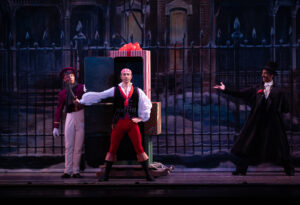
7. Pirate and Penguin Dolls
Two of the dolls that come to life include a penguin carrying a hockey stick and a pirate. These dolls pay homage to the Pittsburgh Pirates and the Pittsburgh Penguins, the city’s baseball and hockey teams.
8. Terrible Towels
In addition to the pirate and penguin, the PBT rats pull out Terrible Towels (a popular local symbol of support for the Steelers) on days that both the show is performing and the Pittsburgh Steelers are playing.
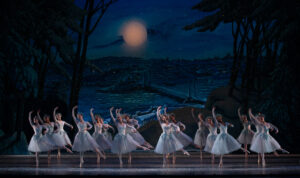
9. Mount Washington Snow Scene
The famous snow scene is set atop Mt. Washington, looking down upon the Point and Pittsburgh’s three rivers. The image is set circa 1906, at about the time PBTs The Nutcracker takes place, offering a beautiful, vintage take on the scene.
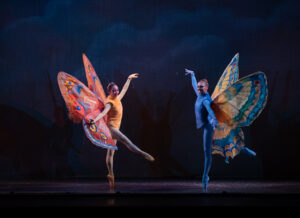
10. Birds and Butterflies
One of Pittsburgh’s treasures is the National Aviary. Once Marie and the Nutcracker arrive in the Land of Enchantment, some of the characters that greet them include birds and butterflies to represent the National Aviary.
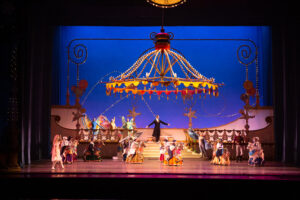
11. Land of Enchantment Amusement Park
The Land of Enchantment is a feast for the eyes, full of bright colors and exciting characters. The set design includes a carousel canopy and figures along with a roller coaster design on the backdrop. These elements pay homage to Pittsburgh amusement parks including Kennywood and turn-of-the-century amusement park, Luna Park.
Not only can you spot these fun references, but this year keep your eyes peeled for some local celebrities on-stage:
| Kym Gable (KDKA-TV Anchor) | Friday, Dec. 8 @ 7:00pm |
| FRYZ (Rap artist) | Friday, Dec. 9 @ 7:00pm |
| Giselle Fetterman (Former second Lady of PA) | Sunday, Dec. 10 @ 4:30pm |
| Daisy Jade (KDKA-TV/Pittsburgh Today Livereporter) | Friday, December 15 @ 7:00 p.m. |
| Lindsay Wade (KDKA-TV Anchor) | Saturday, Dec. 16 @ 2:00pm |
| Boaz Frankel (KDKA and NEXTPittsburgh reporter) | Saturday, Dec. 16 @ 7:00pm |
| Kristine Sorensen (Anchor on KDKA-TV) | Sunday, Dec. 17 @ 12:00pm |
| Scott Blasey (Lead Singer of The Clarks) | Thursday, Dec. 21 @ 7:00pm |
| Kyra Laubacher (Journalist at Pointe Magazine) | Saturday, Dec. 23 @ 7:00pm |
PBT is extremely proud to be part of the Pittsburgh community and to showcase its rich history. With performances throughout the entire month of December, there’s no better way to celebrate the holiday season than with family at PBT’s uniquely Pittsburgh rendition of The Nutcracker! Purchase tickets here!
Violins of Hope
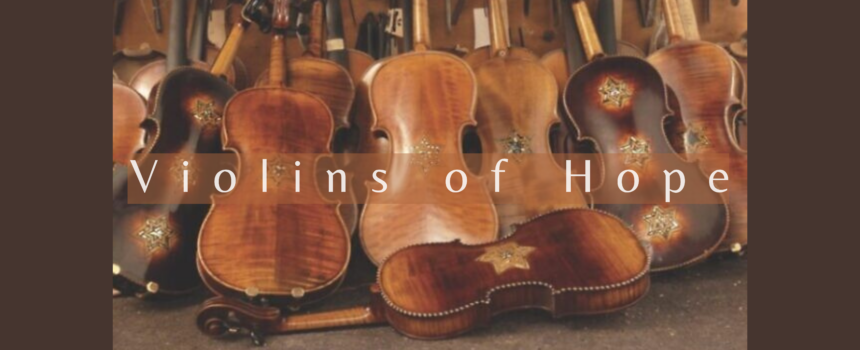
October 27-29, Pittsburgh Ballet Theatre (PBT) will present Sounds of the Sun as part of its seasoner opener in conjunction with Violins of Hope Greater Pittsburgh. Sounds of the Sun is a world-premiere ballet choreographed by Jennifer Archibald. It is inspired by the true life story of Florence Waren, a Jewish dancer and French Resistance fighter during World War ll. During the performance, a violin from the Pittsburgh Violins of Hope exhibit will be played onstage.
The Violins of Hope is a collection of 102 violins, violas and cellos that were owned and played by Jewish musicians both before and during World War ll. Israeli violin maker Amnon Weinstein began the project to collect and restore these instruments and tell their stories. Each instrument conveys the inspiring story of its owner, the pain they endured, the atrocities they faced, the scars of the survivors and the memories of those who did not survive the Holocaust.
The collection strives to educate about the Holocaust and memorialize the original owners through concerts, exhibits and community education events. This unique, free exhibit can be viewed at the Posner Center on Carnegie Mellon University’s campus from October 7-November 21, 2023.
Some of the examples of violins in the poignant collection include:
Joyce Vanderveen Violin
This violin will be played onstage during Jennifer Archibald’s Sounds of the Sun premiere.
The violin belonged to Joyce Vanderveen, a talented and well-known young dancer and musician from Amsterdam, who was just 13 years old when World War II broke out across Europe. Joyce survived with her family and her cherished violin. After the war she became a renowned ballerina and later, a Hollywood actress. It was then that she placed her beloved violin beneath her bed, never to touch it for the ensuing 25 years leading to her death. She also never spoke about the violin of the Holocaust with her son. Her violin found its way back into the spotlight when her son discovered the Violins of Hope project. A symbol of resilience and survival, the violin continues to inspire as it is played once again. Joyce’s legacy lives on through this instrument, a testament to the enduring power of art and music.
An interesting side note is that Joyce’s picture, probably a publicity photo clipped from a magazine, was discovered hanging on a wall in Anne Frank’s bedroom. Anne died at the Bergen-Belsen concentration camp in 1945. The photo remains on the wall at the Anne Frank House, now a museum.
Hecht Violin
This violin belonged to the Jewish family Alex and Fanny Hecht and their sons Fritz and Ernest. The Hechts lived in Germany but emigrated to Amsterdam soon after the war began. After the Nazis invaded Amsterdam, Fanny gave the violin to her neighbor Helena Visser for safekeeping, as she did not want the Nazis to have her prized possession. The entire Hecht family was arrested and sent to different concentration and labor camps. None of them survived. The Visser family kept the violin safe for 74 years until they turned it over to Violins of Hope so that it could be played in the Hecht’s memory.
Lyon Violin
In 1942, thousands of Jews were arrested in Paris and sent to Auschwitz and other concentration camps. On one of the trains was a man holding a violin. When the train stopped in rural France, he cried out, “In the place where I now go – I don’t need a violin. Here, take my violin so it may live!” He then threw the violin out of a train window and a French worker picked it up and saved it. Years later, his children found the violin in his attic and took it to a French violin maker, with whom they shared the story of it. The violin maker knew of Violins of Hope and donated the instrument to the collection.
Henry Brender Violin
Henry Brender was a prodigal violin player who grew up in Romania and studied music in world-famous academies in Vienna and Budapest before World War ll. He was sent to a hard labor camp during the war but escaped along with his violin. He survived the war and became a soloist with the Bucharest Philharmonic. He was later detained and imprisoned for six months by the communist Romanian government. In 1960, he immigrated to Israel and joined the Israel Philharmonic Orchestra, where he played until his retirement in 1985.
Dachau Violin
This violin belonged to Abram Merczynski. In August 1944, 21-year-old Abram and his two brothers, Isak and Zysman were deported from Poland, to Auschwitz and then to Dachau concentration camp. Abram played his violin wherever he was, even in the labor camps. Abram and his brothers survived, as did his violin. Before they emigrated to the United States in 1955, the three brothers rented a room with a German family in Munich. Abram bought himself a new violin and gave his old instrument to the family’s young son. Abram lived to be 88 and his daughter, Eleanor, said he never stopped playing the violin. Abram’s original violin now continues to tell the story of survival, music and friendship.
A Forever Dance Partner

Two real-life Pittsburgh Ballet Theatre couples will be performing Pas des deux at the Light in the Dark program that will open the 2023-24 Season on October 27-29.
Principal artist Yoshiaki (Yoshi) Nakano and Soloist Jessica McCann will perform Lacrimosa on Saturday, October 28th at 7:00 p.m. Lacrimosa, by Annabelle Lopez Ochoa, Yoshi and Jessica have been married for four years, after meeting at PBT. Inspired by Baroque religious iconography, Lacrimosa is a moving work filled with daring lifts and expressive dancing. Lacrimosa also marks Jessica’s return to the stage for the first time in 10 months after she had hip replacement surgery in April.
Diana Yohe, a PBT Soloist and her husband Joseph (Joe) Parr, a member of the Corps de Ballet, will be performing Loss on Sunday, October 29 at 2:00 p.m. Diana and Joe also met while dancing at PBT and have been married since 2018. Loss, by Sasha Janes, tells the story of a couple’s loss of their child. The choreography, set to Samuel Barber’s Adagio for Strings, is a heart-wrenching and emotional duet through which the couple expresses their grief.
Both couples provide insight into what it is like to dance in these emotional works, as well as the pros and cons of dancing with their spouses.
Lacrimosa – Jessica McCann and Yoshi Nakano
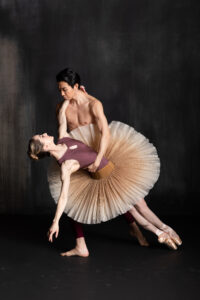
What is it like performing Lacrimosa together as a real-life couple?
Yoshi: It’s really fun and exciting! Having the same stage experience together, I will always remember the feeling of togetherness dancing with Jess. We have performed this duet during the pandemic, so I didn’t feel like my body was in shape, but this time I feel fully back and ready to perform!
Jess: Having performed this beautiful duet before in 2021 together, I’ll never forget how easy it was to trust him. It’s an incredibly hard duet in the sense that my role is almost blind the entire time, and we are falling into our partner’s arms and jumping trusting they are ready! Dark lighting, our hair is down, and we are giving it everything. It could be very scary but with him, I feel safe and can trust him with my life.
What are the benefits and challenges of dancing with your spouse?
Yoshi:
Benefit: I can always expect what she needs from me because we know each other so well.
Challenges: Trying not to be personal about how to fix some issues in this piece.
Jess:
Benefit: That connection is real, and it’s an absolute joy of mine to perform with my love and share our passion for art together.
Challenges: Sometimes when you are too comfortable with each other you can be more critical. As a married couple, we both try to actively listen to each other’s thoughts and feedback while working in the studio together. We’ve been lucky enough to dance together for several years now so each time we get better and better at it.
What is your favorite part of Lacrimosa?
Yoshi: The very beginning as soon as I touch her, she starts breathing. It’s like she comes back to life. The moment of the stage is incredibly beautiful with the lighting and music.

Jess: The ending! When I get more and more limp in the choreography, to the point of death, he has me in his arms in a tight embrace as he slowly lowers me to the floor. At that point, I’m sweating, breathing heavily and my hair is in my eyes as my face finds the floor. It’s a sad moment but a satisfying ending to this beautiful duet.
What is the most challenging part?
Yoshi: To make everything look smooth and effortless.
Jess: Not falling, and making everything look effortless while conveying the story.
Jessica – how does it feel to be back onstage only 6 months after your hip replacement surgery?
I didn’t think I would feel ready at this point I’ll be honest. But I’ve been working tirelessly, and patiently for my return to the stage. It’s an incredible gift that I will hold close and never forget. I don’t feel nervous, I feel like I’m returning home from a long journey where I saw and learned so much, and grew exponentially as a human. And to return with my husband who has supported me through all of my hardest moments is like the cherry on top of this whole experience.
Returning with such a dramatic duet like Lacrimosa will be my love letter to the stage, to the audience, and to my recovery journey thus far.
Loss – Diana Yohe and Joe Parr
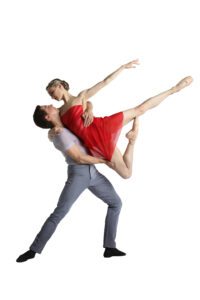
What is it like performing Loss together as a real couple?
We both feel it helps us be more honest in our performance. We’ve experienced loss and have
grieved together, so it is not hard to put ourselves in that frame of mind.
How do you prepare for the performance?
Each time before we run the piece we usually give each other a hug to center and ground ourselves. Sasha Janes (the choreographer) also encouraged us to always take a moment alone to get into the mindset that we just experienced a devastating loss in our lives. We both thought of the opening running that we do in the pas de deux as preparation as well.
Joe: I imagine that I’ve been running for a long time to find Diana. Once I do catch her I feel the desperate need to talk to her but I have no oxygen or words to speak. Almost the feeling of gasping for air after you’ve swallowed water down the wrong pipe.
Diana: I think of the moments in my life when I’ve learned something horrible and all I want to do is run away and pretend it doesn’t exist. It kind of feels like an out-of-body experience until I run into Joe and I come rushing back to reality.
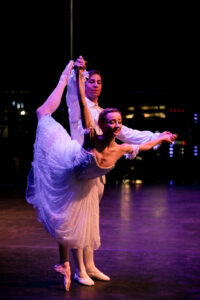
Do the emotions from the piece ever carry over into our lives?
Joe: I feel I can generally separate the work from carrying over into life.
Diana: Sometimes I think because I’ve opened the door for those emotions to carry through, that it doesn’t quite shut all the way. I think more often of the people in my life that I’ve lost for sure and I feel this piece both helps me to process that grief but also keeps it more alive at the same time.
What are the benefits and challenges of dancing with your spouse?
We find it’s possible to ask more of each other, which is both a benefit and a challenge! There is also no shying away from the emotions of the piece and the love we have for each other.
What is your favorite part of the piece?
We love just being lost in the movement together. Even though it is an intense and technically challenging piece, there is a special connection and closeness we feel each time we run it.
What is the most challenging part?
The most challenging was to remain as human as possible in our acting and not add the ballet dancer in us to the steps. Also, physically it definitely took time to have the stamina to run the pas de deux in its entirety. The choreography requires that you are constantly resolving the movement. It’s important to trust the difficulty in the steps and in a way, use that difficulty to get the message of the piece across.
Light in the Dark Casting
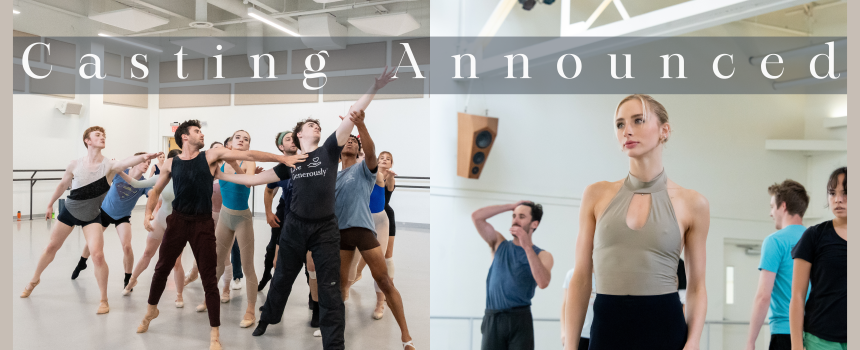
Pittsburgh Ballet Theatre has announced casting for the 2023-24 season opener, Light in the Dark. The mixed repertoire program features four poignant contemporary works that showcase powerful stories and passionate dance. The program includes Jennifer Archibald’s world premiere Sounds of the Sun, Barak Marshall’s company premiere Monger, Loss by Sasha Janes and Annabelle Lopez Ochoa’s Lacromosa. These emotional ballets tell compelling stories of tragedy, hope and human connection. The program runs October 27 – 29 at the Byham Theater.
Images from Jennifer Archibald’s Sounds of the Sun studio rehearsal.
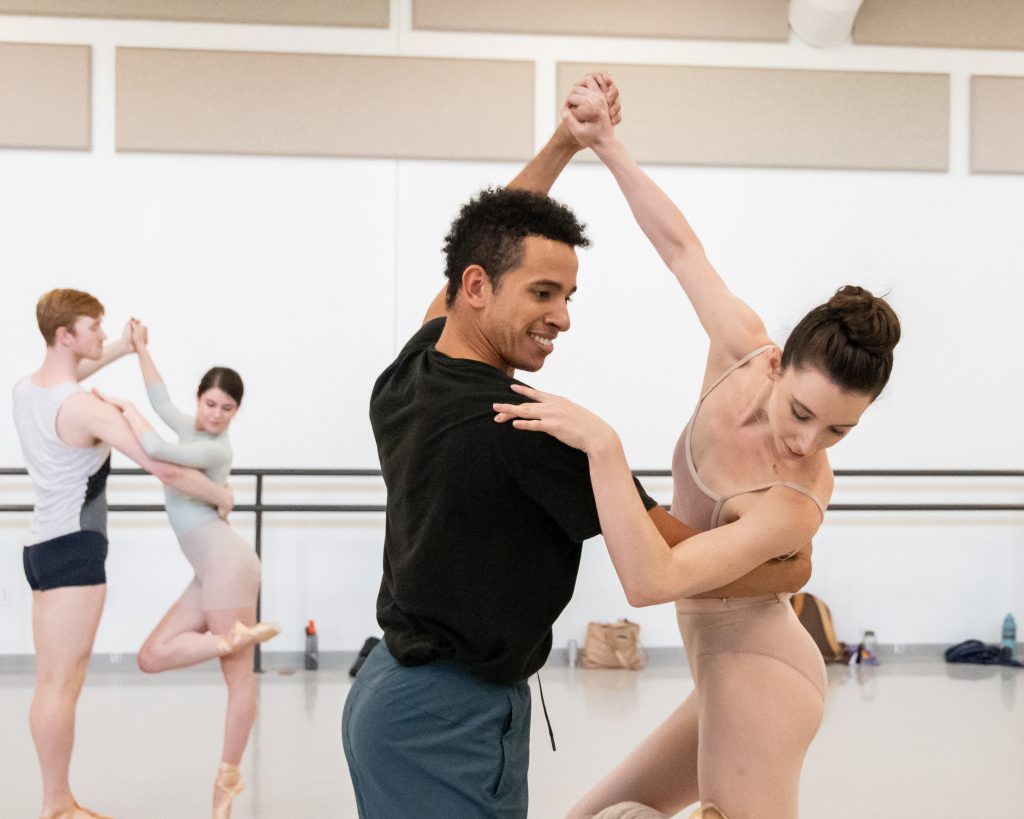
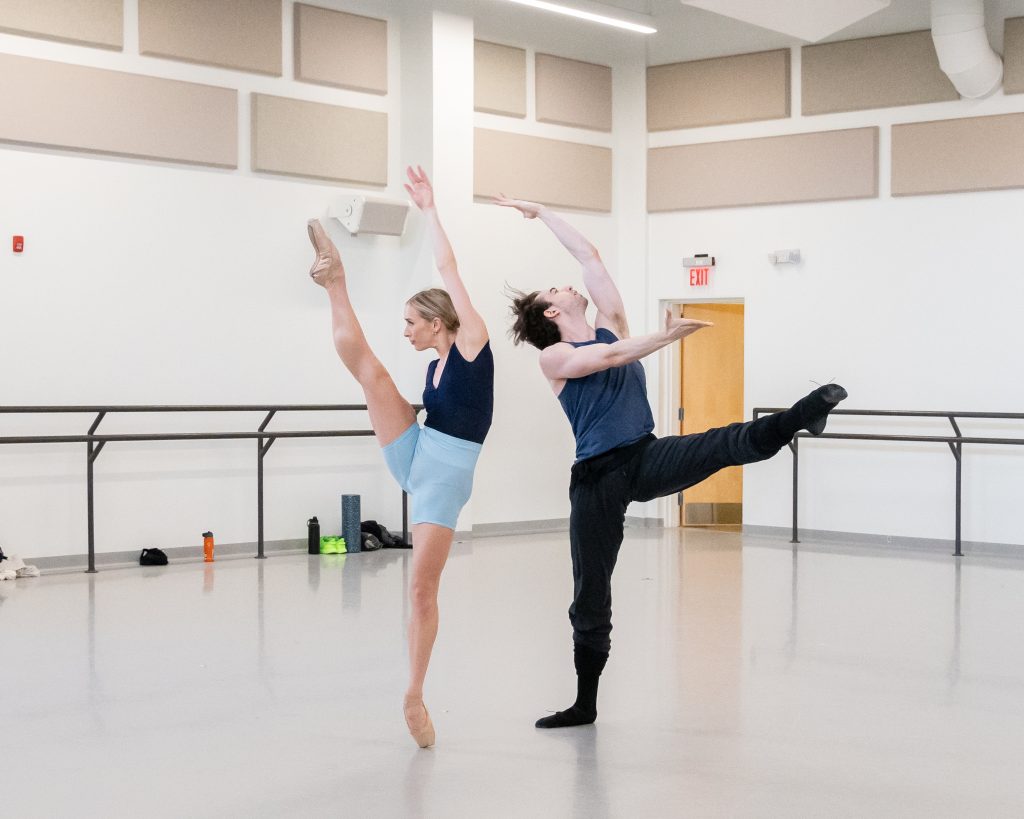

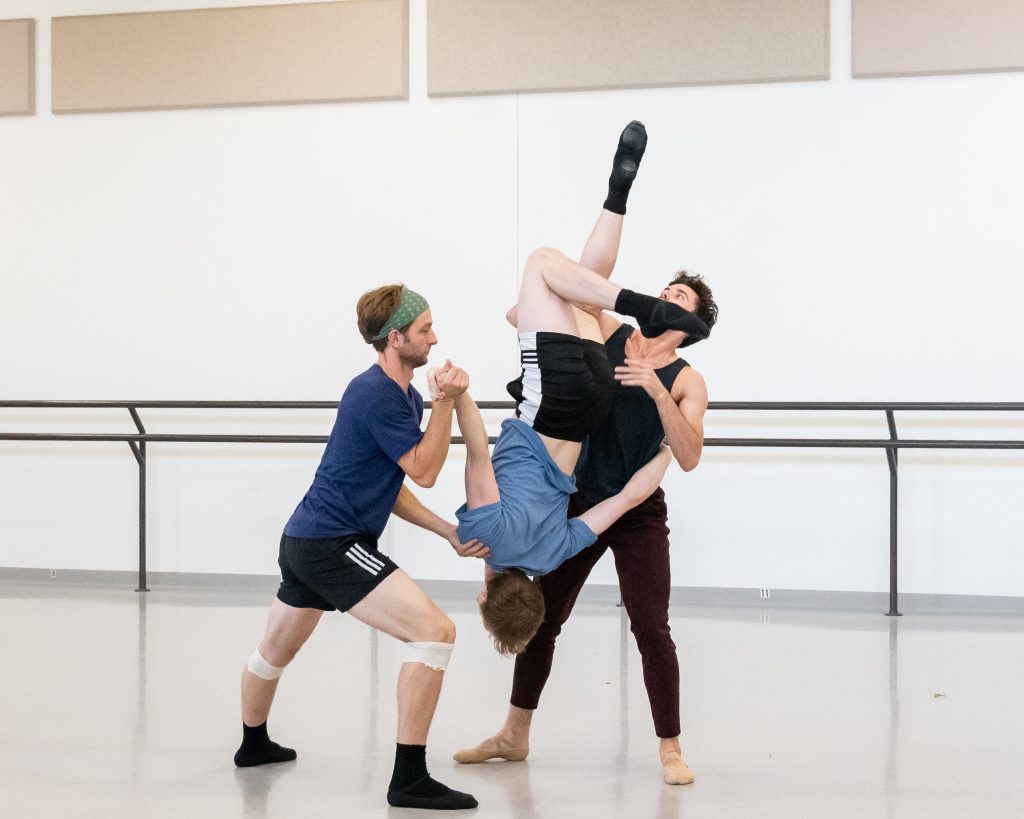
Celebrate National Coming Out Day with PBT!
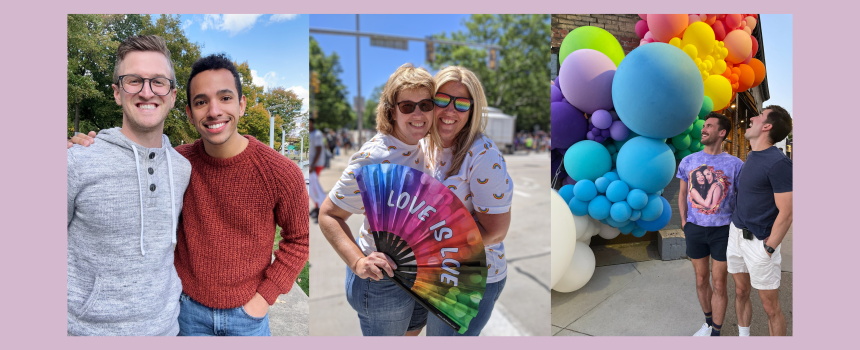
At Pittsburgh Ballet Theatre, we are committed to increasing equity, diversity and opportunity in the art of ballet. We believe that by bringing together people with diverse perspectives, histories and life experiences, we can create more vibrant experiences for everyone.
As part of this, PBT is proud to support National Coming Out Day on October 11th. This is the 25th year that this important day has been celebrated in the U.S. This annual LGBTQ awareness day celebrates people acknowledging – both publicly and privately – their authentic selves and embracing who they are. As part of National Coming Out Day, three PBT artists/staff members are sharing their coming out stories in hopes of inspiring others.
Kurtis Sprowls

Can you share your coming-out story with us?
I knew I was gay from a very young age. I struggled to really accept my authentic self, and live up to the expectations of my hometown environment. In my late teens, I moved to Pittsburgh and I was able to find community and acceptance in myself. I started to come out little by little and was met with many different reactions. Looking back at this time in my life, I am grateful for the people who have always shown me unconditional love, and for the patience I granted people who needed time to process. I believe my coming out stands as a testament to that it does get better.
Where have you discovered a supportive and inclusive community?
I have had the great fortune to discover many supportive and inclusive communities since coming out. I have found a core group of queer friends who love and support me, and make up my chosen family. I have also found support and community at Pittsburgh Ballet Theatre. At PBT, everyone can be themselves and showcase what is unique and special about who they are. Through the support that PBT offers, everyone can confidently grow and flourish.
What advice do you have for individuals struggling to come out?
My advice to someone who is struggling to come out is to trust your gut, take your time, and practice patience. There is no rush to come out, so take your time and space to really get to know your authentic self. Cultivating patience with yourself and others will not only bring you peace but will help strengthen the bonds and relationships you value. Coming out looks different for everyone, but you will never regret living authentically as your whole self. Always remember that you deserve love, acceptance, and respect just as much as anyone else.
As a member of the LGBTQ+ community, who or what inspires you?
As a member of the LGBTQ+ community, I am inspired by the generations of queer folks who came before me. I am incredibly lucky to have the life I have today because of their bravery and visibility.
Lish Reece

Can you share your coming-out story with us?
I really don’t have some grandiose movie story to share – it sort of just happened. I do want to say that I am blessed to have a loving and supportive family because I know that is not always the case.
Where have you discovered a supportive and inclusive community?
I have definitely discovered a supportive and inclusive community in the arts. I believe so many LGBTQ+ people are drawn to the arts even before they realize that they may be wondering about how they identify. The creative nature of our arts communities tends to value self expression. We are in the business of portraying others thoughts and feelings and words which hopefully creates a brave space for exploration. This environment also lends itself to further understanding of humans as a whole and the realization that we are all so different and wonderful and also so alike!
What advice do you have for individuals struggling to come out?
The biggest advice I have is to not feel pressured to come out, it is something that is deeply personal. Everyone’s experiences and situations are unique. Was coming out freeing to me? Absolutely it was. Yet you need to do what is right and safe for you. I believe the most important step is learning to love and appreciate yourself first because you are valid!
I grew up in a very small conservative town and I absolutely understand the difficulties that presents. I had already moved away when I finally acknowledged that being a part of the queer community was my truth. Thankfully the understanding and appreciation of people who identify as LGBTQ+ in those pockets of rural America are finally starting to progress.
If/when you decide to come out – just know that it is a continual process. I still find myself coming out to people that I haven’t met or haven’t seen since high school. Has it gotten easier and easier over the years? Completely yes. This is because I have become more and more comfortable with myself and also, thankfully, the world is evolving. It also certainly helps that I can just post a picture of myself and my partner to social media and I have “come out” just by living my life. My hope is someday “coming out” won’t even be a thing. We will all just be.
As a member of the LGBTQ+ community, who or what inspires you?
I know I have worked in the arts for the majority of my life, but I actually draw quite a bit of inspiration from LGBTQ+ athletes. Professional athletes have such a visible platform and many LGBTQ+ people have used that stage to inspire and educate the world. Even the uptick of LGBTQ+ commercials during certain sports broadcasts has increased as of late. That representation can have a profound effect on someone whose circumstances may not allow them to see LGBTQ+ people on a daily basis.
Matthew Griffin

Can you share your coming-out story with us?
I knew I was gay for a long time; but never thought I would come out. When I graduated high school and went to college, I realized a lot of the pressure I was feeling about coming out, I was putting on myself. So in college, where I knew I had a safe group of friends, and decided to just go for it and be my authentic self. Nobody batted an eye, so I brought my authentic self home with me on my first break. My family and hometown friends were unfaltering with their love and support.
Where have you discovered a supportive and inclusive community?
I’ve found a supportive community in my friends and my family. I’ve also found a supportive community in the arts. I am grateful to be able to work at PBT where I can bring my full self to work everyday.
What advice do you have for individuals struggling to come out?
Everyone’s journey is different. Give yourself the time you need and give yourself grace. Just know that there are people out there who love you and accept you for who you are.
As a member of the LGBTQ+ community, who or what inspires you?
Inspiration is everywhere for me. Music, books, concerts, shows, movies, television, and the culture are all things that inspire and inform me. I’m inspired by fearlessness and authenticity. I’m inspired by the generations of queer people before me who paved the way for us to live our lives so freely today.
Learn About Florence Waren
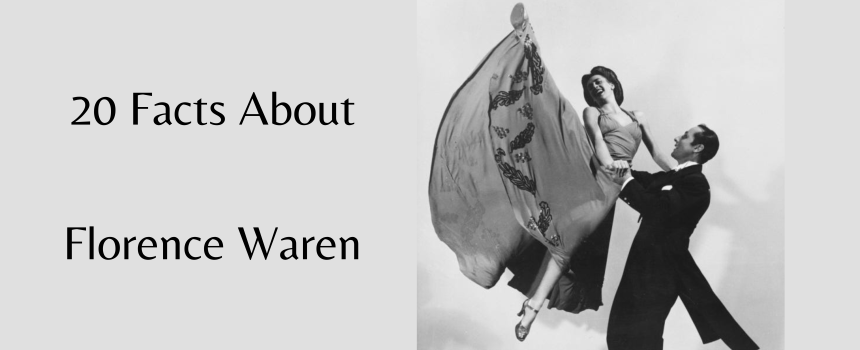
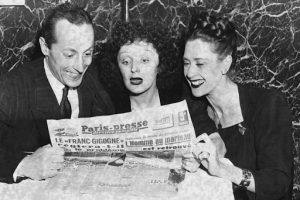
The central work in Pittsburgh Ballet Theatre’s 2023-24 season opener Light in the Dark is renowned choreographer Jennifer Archibald’s world premiere Sounds of the Sun. This documentary-based contemporary ballet celebrates the life and bravery of Florence Waren, a Jewish dancer who lived in Paris during World War II and worked with the French Resistance.
Florence Waren was a famous dancer in both France and Germany during World War II. Together with Frederic Apcar, she became part of one of the most popular ballroom dance teams in Europe – “Florence et Frederic.” After the occupation of Paris, Florence decided not to reveal her Jewish ancestry and to instead risk hiding in plain sight.
“She led a rather adventurous life,” her husband Stanley Waren told The New York Times after her death. “Wherever she went, she somehow became part of the scene, and people helped her and she helped them. She didn’t want anything from anybody except to work. She was really one of those natural-born performers who loved what she was doing.”
20 Facts About Florence Waren’s Heroic Life
- She was born Sadie Rigal in Johannesburg, South Africa in 1917, one of seven children.
- After seeing Ballet Russes as a child, Florence fell in love with dance and began taking lessons
- One of her lasting ballet memories was when a teacher hit her in the calf with a cane. Florence grabbed the cane and broke it and was then forced to buy the teacher a new one before being allowed back in class.
- She moved to France in 1938 and was hired as a dancer by the famous Bal Tabarin Music Hall in Paris, changing her name to Florence soon after.
- In 1939, she was offered a place in the Ballet Russe de Monte Carlo, but World War II began before she could join.
- She was arrested held in an internment camp for several months in 1940 because she was South African, and therefore a British citizen (and as such a Nazi enemy alien).
- She and her dance partner Frederic Apcar often performed at the same clubs with world-renowned Édith Piaf and Maurice Chevalier.
- During the occupation of Paris, Florence frequently performed for German officers at the Bal Tabarin, while hiding her Jewish identity in the spotlight the entire time.
- She aided the French Resistance by hiding fellow Jews in her apartment, helping Jews find safe houses and smuggling supplies and guns.

Florence Warren with her dance partner Frederic Apcar. - After a performance at a French POW camp in Germany, Florence illegally collected letters prisoners had written to their relatives and took them back to France to distribute.
- During the war, a French police officer covertly warned her that her house was going to be raided by the Nazis and that she needed to move the Jews that were hiding there.
- In 1944, Frederic rented a house in the suburbs to hide her and several other Jewish performers after learning Florence was to be arrested.
- Florence and Frederic saw American soldiers in tanks asking for directions to Paris in 1944 and followed them, witnessing the city’s liberation.
- In 1948, she met Stanley Waren, an actor, director and teacher, while performing at the Copacabana in New York.
- On their first date, Florence and Stanley went to a delicatessen and got into such a loud argument that they were thrown out.
- They were married in 1949 and Florence decided to leave “Florence et Frederic.”
- In New York, she began a new career, appearing in Broadway plays and on television, including The Ed Sullivan Show.
- From 1973 until 1983, she was a professor of theater and dance at New York City College, heading the department for part of that time
- She was a dance panelist on the New York State Council on the Arts.
- She died in New York City in 2012 at the age of 95
Banner Photo: Florence Warren with her dance partner Frederic Apcar | All photos courtesy of United States Holocaust Memorial Museum
Celebrate Hispanic Heritage Month with Apprentice Cecilia Hernandez
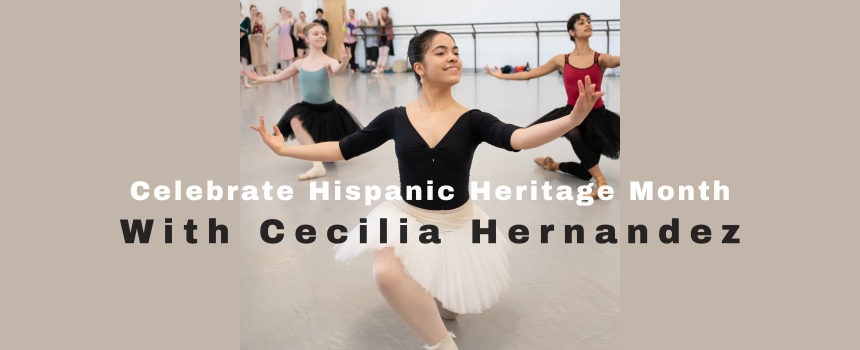
National Hispanic Heritage Month begins September 15! We were excited to sit down and talk with PBT artist Cecilia Hernandez to learn about some of her family’s cultural traditions and customs.
What is Hispanic Heritage Month? Hispanic Heritage Month celebrates the histories, cultures and contributions of American citizens whose ancestors came from Spain, Mexico, the Caribbean and Central and South America.
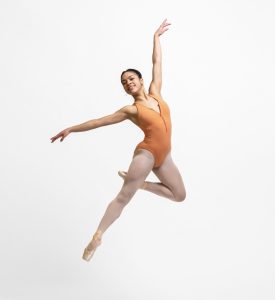
Can you share a bit about your culture with us?
I am half Colombian and half Puerto Rican. Even though I was born in the U.S., my parents instilled many traditions. Both nationalities have delicious cuisines and music. We love to dance cumbia and salsa. Family is very important in our culture and we take care of our elders.
Do you feel like your identity is tied to your heritage?

My great-grandmother became a widow at 40 years old in Colombia and she baked cakes to help support her family of 9 children. To this day, we still use her recipe on special occasions to celebrate her. My grandmother is one of the most meaningful people in my life and one of the ways she kept my family, specifically the ladies, tied to our culture was throwing us quinceañeras, which is very popular in Latin countries. When most of my friends were having Sweet 16 parties, I had a traditional quinceañera for my 15th birthday with 14 friends as part of my “court.”
What are some of your favorite memories growing up?
One of my favorite memories about growing up in my culture is the Christmas celebrations. Colombians, and most Hispanics, celebrate on Christmas Eve, and we gather together, pray, dance, play games and open gifts late at night (which was my favorite part).
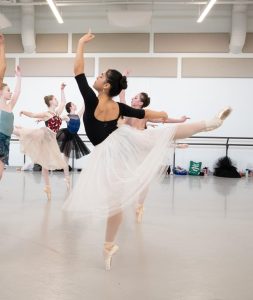
What are your favorite family traditions?
My favorite cultural tradition in my family is the family gatherings we would have each Saturday. We ordered Colombian food, talked about our week, danced, and played Dominos, which is a significant game in Hispanic culture. My grandfather is the best player I know!
Celebrate Hispanic Heritage Month with Corps Member Christian García Campos

National Hispanic Heritage Month begins September 15! We were excited to sit down and talk with PBT artist Christian García Campos to learn about some of her family’s cultural traditions and customs.
What is Hispanic Heritage Month? Hispanic Heritage Month celebrates the histories, cultures and contributions of American citizens whose ancestors came from Spain, Mexico, the Caribbean and Central and South America.

Can you share a bit about your culture with us?
I think Mexican culture is incredibly rich in every aspect, from the food to the architecture, from the music to the beautiful and varied sceneries. It’s so full of color and vibrancy, like the dresses worn for Mexican folklore, the incredibly elaborate mariachi suits, the “alebrijes” (imaginary creatures made up of a combination of animals), the “Voladores de Papantla” (Dance of the Flyers), the list is truly endless.
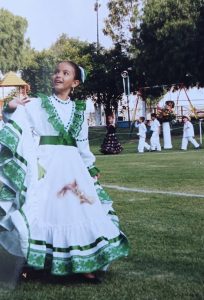
Do you feel like your identity is tied to your heritage?
It absolutely is. Latin people have this warmth about them, it’s probably one of the things I miss most from home. There is this carefree spirit that people carry. There’s never a lack of reasons to get together and celebrate, even if it’s just to be with each other. And I have to say, I’m definitely feisty.
What are some of your favorite memories growing up?
I want to say that my parents truly went above and beyond. They made everything special. In Mexico, the three wise men visit you just like Santa Claus does. Whenever they came to visit, our living room was turned upside down. Literally. There was hay all around and sometimes the horse would even leave a little present as well… a wall size letter was written outside, it was truly unbelievable. They made me believe it was all real.
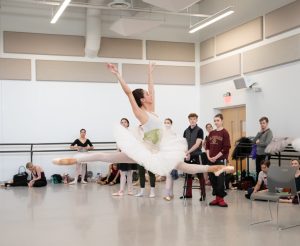
What are your favorite family traditions?
I would have to say that our rituals during New Years Eve take the cake. As we ring in the new year, we have several tasks that need to be completed. There would be a suitcase, and someone would have to go around the block with it. This would be for future traveling. Someone would be throwing lentils outside for abundance. Someone would sweep the entrance to get rid of bad energies. All of this while someone rings a bell, eat your grapes and hug each other to receive the new year. I love my family.
Open Air at Hazelwood Green Casting Announced
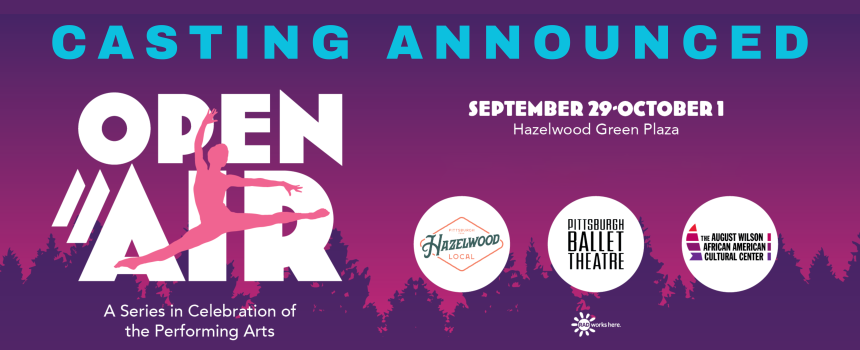
Pittsburgh Ballet Theatre’s Open Air performance at Hazelwood Green will be happening on Friday, September 29 and Saturday, September 30 at 7:30 p.m. The outdoor performance is free to attend and open to the community.
Casting has been announced!
In addition to PBT performances, the family-friendly event will include performances by other musical and dance artists, as well as art vendors, demonstrations, kids activities and food trucks all weekend. PBT will also hold barre classes for adults and creative movement classes for kids. Additionally, Saturday is August Wilson Community Day and will include free activities from numerous local museums and arts organizations. Open Air will run on Friday, Sept. 29 from 6:00-9:30 pm, Saturday, Sept. 30 from 11:00 am – 9:00 pm and Sunday, Oct. 1 from 11:00 am – 5:00 pm. See the full schedule here.
Hear From the Company and School Accompanists
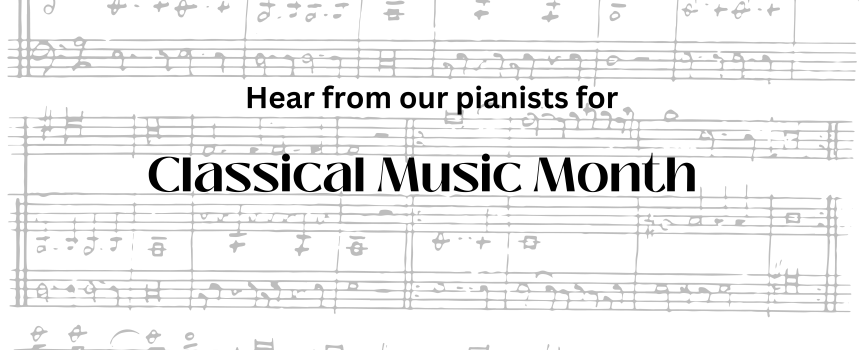
Ballet and classical music are intrinsically linked. Most beloved classical ballets from Tchaikovsky’s The Nutcracker and Swan Lake to Prokofiev’s Romeo and Juliet and Stravinsky’s The Firebird have sweeping musical scores that not only accentuate the dancing but help to express character’s feelings. Most classical ballet scores, also stand on their own as music compositions even without the ballet.
Many ballet theaters – including PBT – are fortunate enough to have pianists who play live music for classes and rehearsals. In honor of Classical Music Month, we want to highlight PBT’s accompanists and how they feel live music impacts rehearsals. We’ll also show an inside look at their favorite pieces to play in the studio.
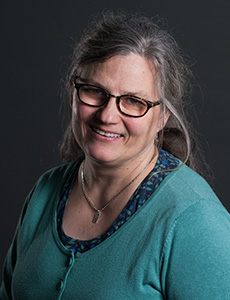
1. How do you believe live music impacts studio rehearsals?
Live music in the studios allows for in-the-moment artistic collaboration among dancers, teacher and musician. The musician responds immediately to the movement, the dancers react in turn to the dynamics of the music. Ideally, we are a healthy living organism, breathing and moving together; ideally, the musician is inspiring both teachers and dancers to create their best work in the moment, to improve each day as a technician and an artist.
I’m so glad Pittsburgh Ballet Theatre School is committed to live music in the studios for all its students. I feel so fortunate to have been a part of this project for so many decades.
2. What is one of your most favorite pieces to play in the studio?
I’m afraid I have too many favorite pieces to mention. There is a great thrill, at any moment, in matching a piece perfectly to the dance, no matter what the music. Even so, some things I love are: the slow movement of Shostakovich’s Piano Concerto No. 2 (see Kenneth MacMillan’s Pas de Deux). It requires very slow moving choreography, so I don’t get to play it very often. I still love Kingdom of the Shades from La Bayadere and a few slow and evocative piano works of Bach and Mozart. I still enjoy playing the very sweet Minuet from Gluck’s Orfeo, Faure’s Sicillienne (from Jewels), and some selections from Copland’s Rodeo, including Saturday Night Waltz.
 Juliet Winovich
Juliet Winovich
1. How do you believe live music impacts studio rehearsals?
In an interactive dynamic environment like a ballet studio work,
Live music is, the spatial medium that unifies the group action. The quality of rhythm alone,
Is as powerful as turning on the light in a dark room.
Not only is live music a source of motivation and inspiration, it is also a tool that responds
quickly, adjusting as needed, to facilitate emergence.
2. What is one of your most favorite pieces to play in the studio?
It depends on the work being done at that moment.
 Sun Chang:
Sun Chang:
1. How do you believe live music impacts studio rehearsals?
I believe it creates a sense of community and a feeling of support between the pianist, dancers, and the instructor. It also makes it feel very much like a living art form, and it feels creative!
2. What is one of your most favorite pieces to play in the studio?
I love playing the Rose Adagio from sleeping beauty by Tchaikovsky!
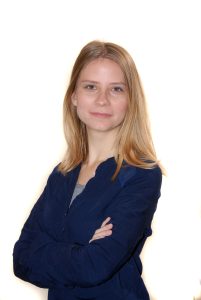 Maja Petrovic:
Maja Petrovic:
1. How do you believe live music impacts studio rehearsals?
Playing for dance classes and rehearsals is such a creative process, that process changes and affects the energy, the mood, and the dynamic of one’s dancing.
From the very first note we play, we initiate this inspiring collaboration with the dancer, and together we create an artistic space where they can express all those qualities in a different way every time they hear a certain piece of music.
2. What is one of your favorite pieces to play in the studio?
Being a classically trained pianist myself, I tend to gravitate towards classical piano pieces that I can arrange in ballet format, and I also enjoy excerpts from ballets. Some good examples are the 2nd movements of Ravel’s piano concerto and Tchaikovsky’s Piano Concerto No. 1. From ballet repertoire, I enjoy playing La Source’s Romance, from Act 3, and scenes from Prokofiev’s Cinderella, and Romeo and Juliet.
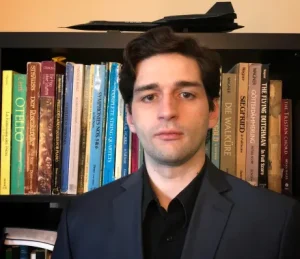 Josh Malave:
Josh Malave:
1. How do you believe live music impacts studio rehearsals?
I believe live music in the classes creates a unity between everyone involved, we share in each other’s striving to make something that is real and which is good.
2. What is one of your favorite pieces to play in the studio?
One of my most favorite pieces to play is a waltz from the opera La fanciulla del West by Giacomo Puccini
Find Out What Our Artists Were Up to This Summer
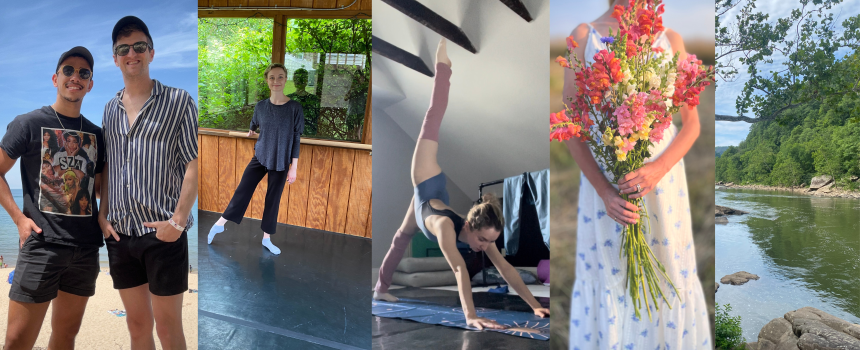
During June and July, PBT Company artists have a well-deserved summer break before the new season begins. Some of the PBT artists shared the different ways they spent their breaks outside of the PBT studios this summer!
JACK HAWN
I took a road trip up to Northern Michigan where I vacationed in cabins on a lake with my family, then all the way down to Miami and the Florida Keys and back to Pittsburgh. Stops and fun along the way included New River Gorge National Park, the Blue Ridge Parkway, Asheville, Atlanta, and Orlando. Four weeks on the road and many memories in my Jeep!
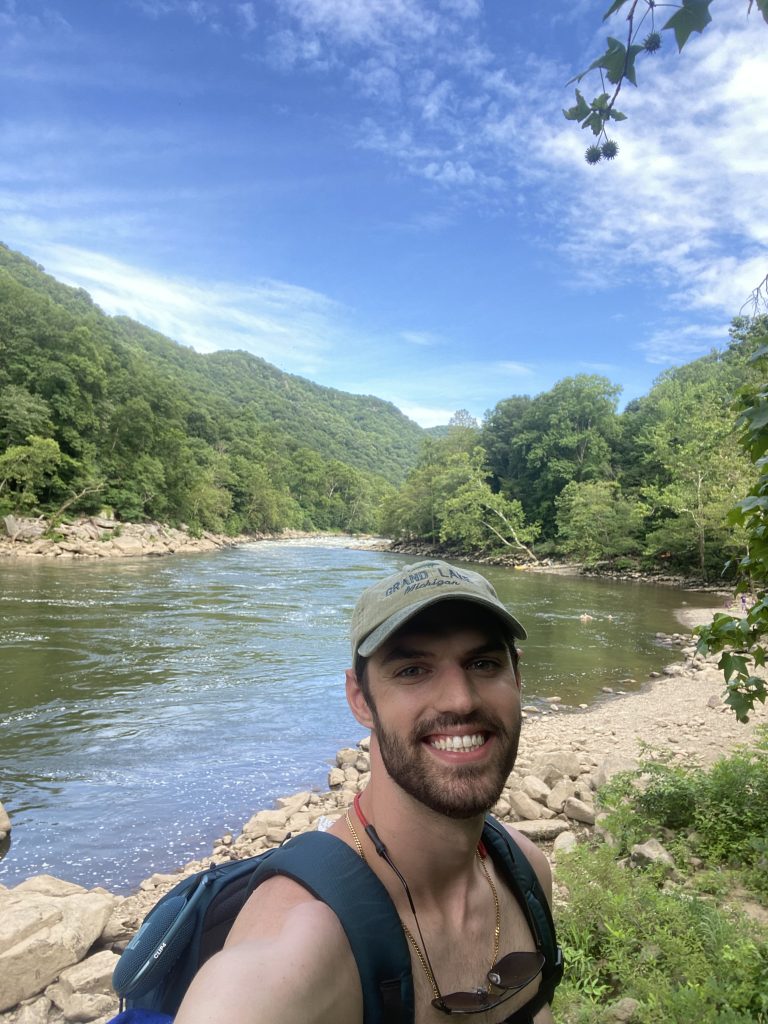
DANIELLE DOWNEY
I spent my summer flower farming — growing cut flowers for market bouquets, arrangements and events. I grew 50+ varieties and have farm-fresh bouquets available for purchase through the first frost this fall. I also just enjoyed the time off with my family, doing all the outdoor summer adventures, relaxing, and waiting on the arrival of baby #2 in October!

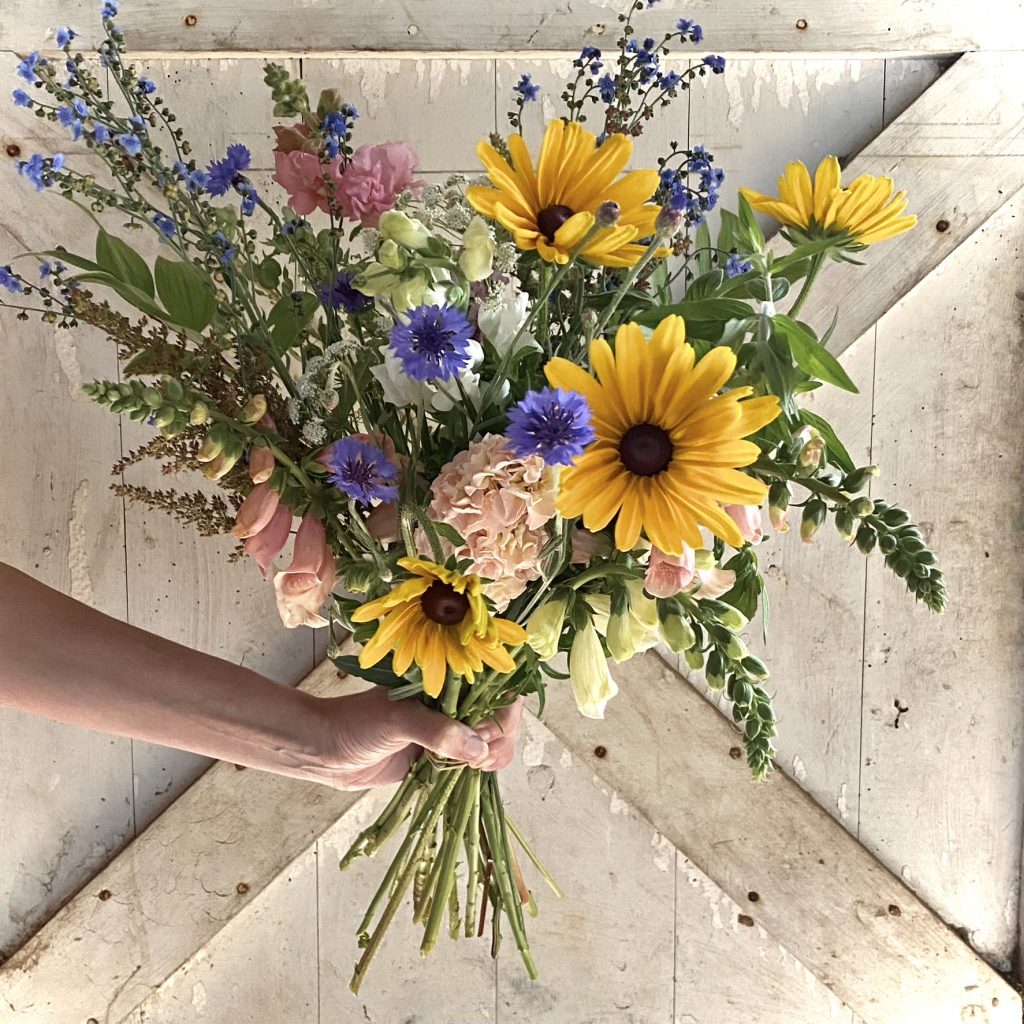
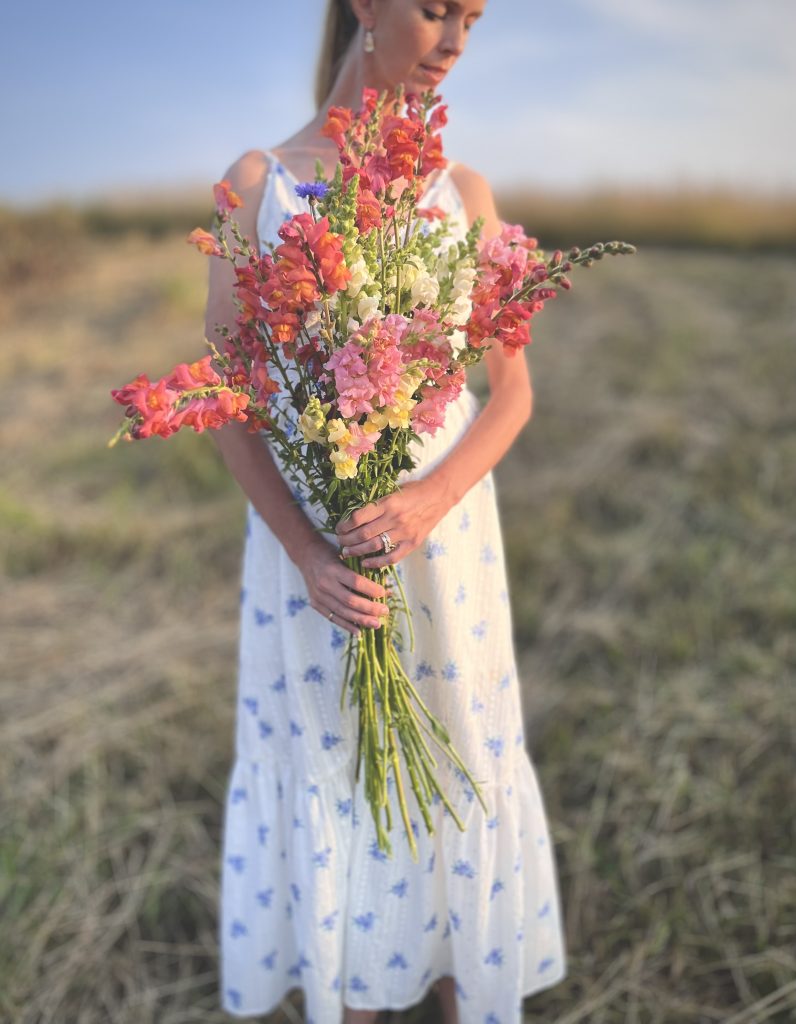
MATTHEW GRIFFIN
This summer was an eventful one! My partner and I started the process of getting ready to move to Pittsburgh! Amidst all of the chaos and the moving boxes, we did a getaway to Lake Michigan, saw the Taylor Swift Eras tour, and even had time for a family vacation to the Caribbean! We made our way to Pittsburgh in late July and settled in just in time to start our new jobs! Looking forward to experiencing everything the city has to offer!

DIANA YOHE & JOE PARR
Joe and I spent most of the summer visiting our family and friends. We also added a sprung floor in our back shed, so we could dance and work out at home. (Thank you, PBT, for the Marley back from Covid times!) The biggest highlight was definitely visiting Long Boat Key, FL with family, which was incredibly relaxing and soul-filling. We spent time enjoying the sun and the sand!
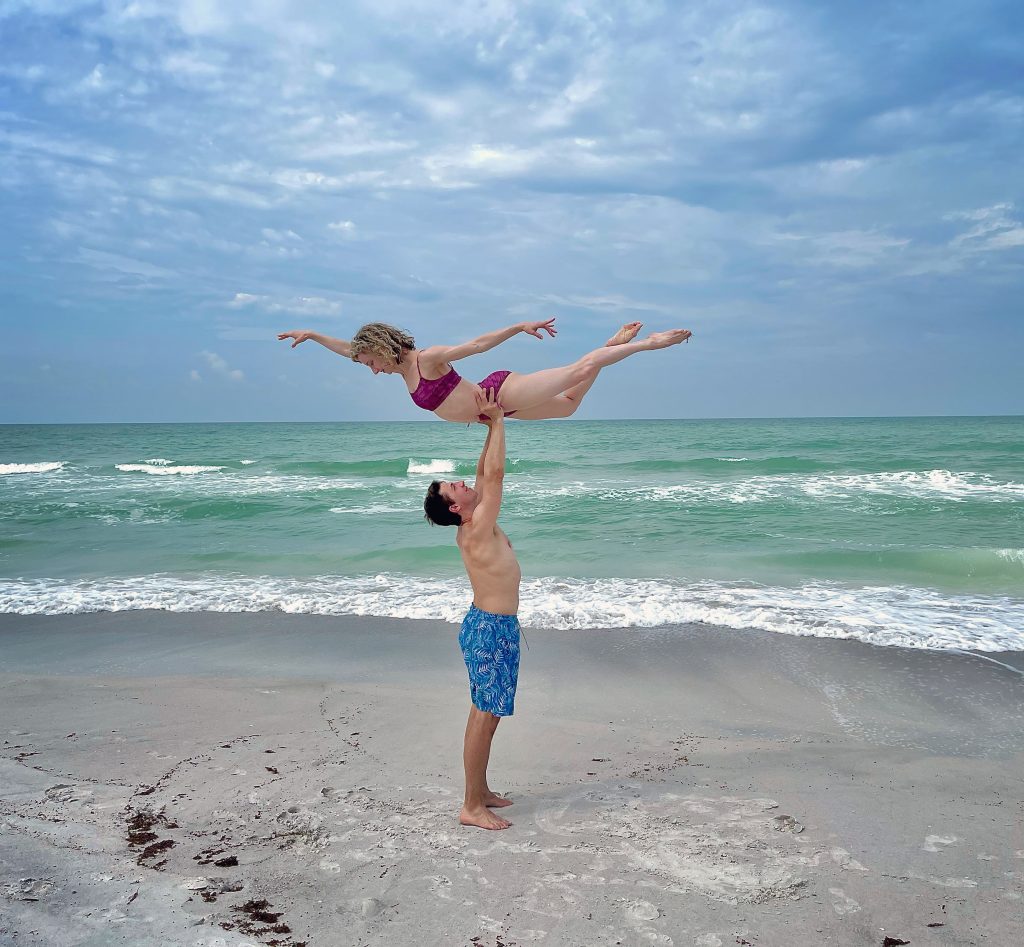

JONATHAN BREIGHT
I spent the summer at PBT teaching classes at the PBT School’s Company Experience and Intensive Summer Program!
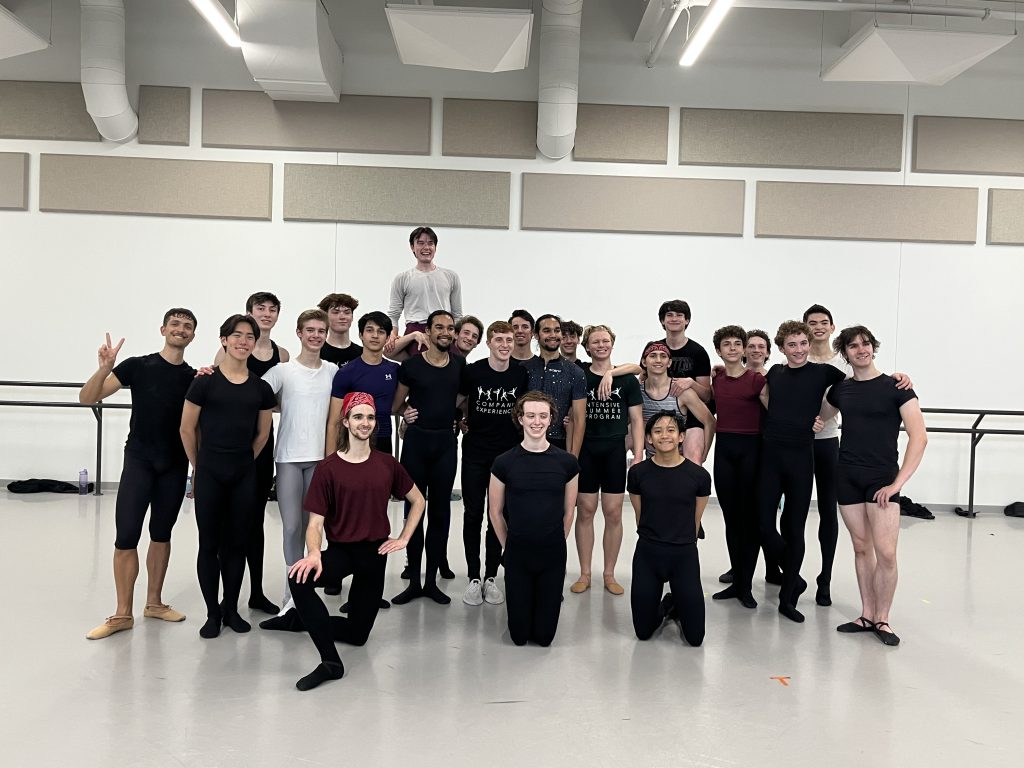
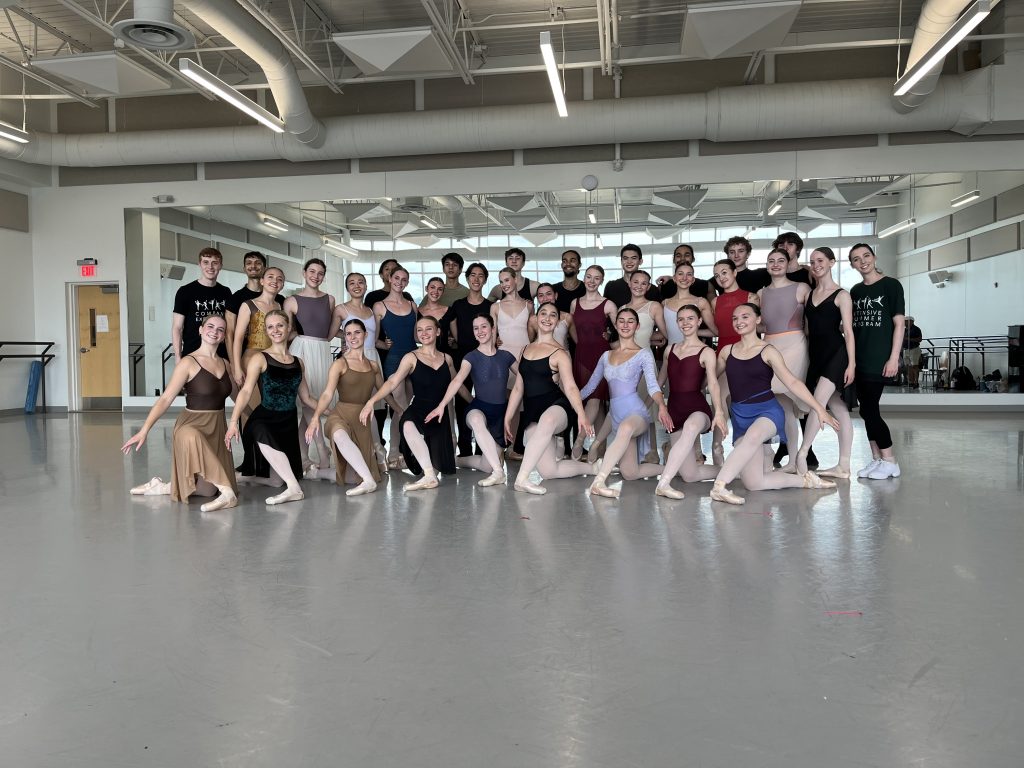
JESSICA MCCANN
I’m currently almost 4 months post op, and I’m doing very well. I started with the company this August taking classes.
I recently started a podcast and have documented every part of my process so I can hopefully bring hope to other dancers out there going through the same thing in silence.
I want to be an example, and proof that coming back after a hip replacement is possible. It’s happened before but it’s been poorly documented and hardly spoken about. I personally struggled to find examples before I got my surgery.
I had to take myself out for the end of our 2022/2023 season but my pain is gone and I’m working on planning my return performance! So it’s been a summer of metamorphosis for me!

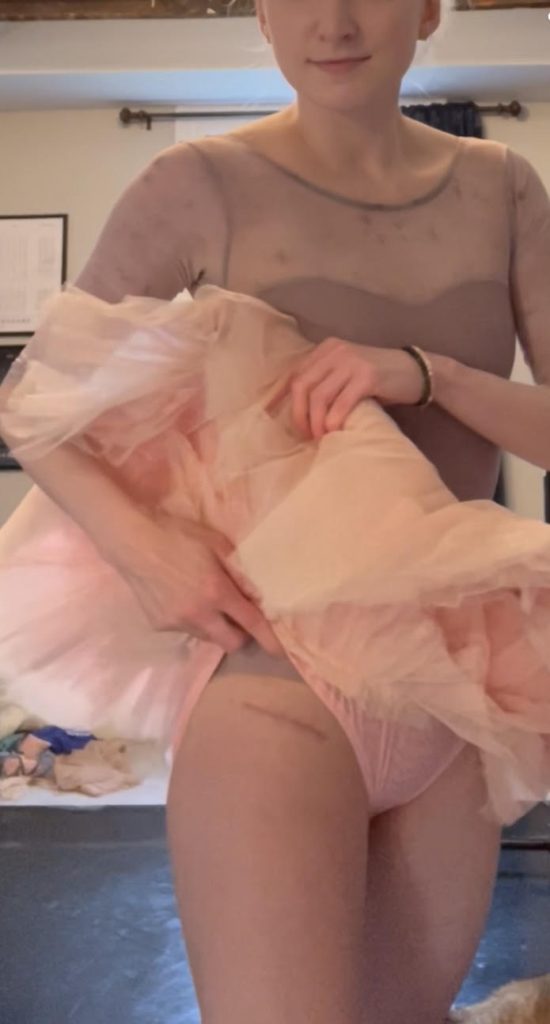
Ballet Under the Stars Casting Announced
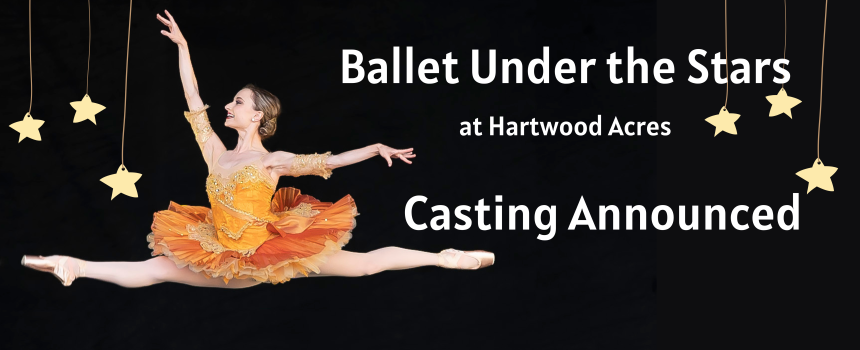
The casting for Pittsburgh Ballet Theatre’s annual Ballet Under the Stars performance at Hartwood Acres has been announced! PBT will be performing at Hartwood Acres on Sunday, August 20 at 7:30 p.m. as part of Allegheny County’s 2023 Summer Concert Series. The outdoor performance is free to attend and open to the community.
Attendees are invited to arrive early to enjoy picnics, food trucks and free kids’ stations, including grab-and-go crafts, face painting, balloon art and a dance class led by PBT team members.
From 5:30 to 7:30 p.m., PBT will host a pre-show Picnic in the Park. Join fellow ballet enthusiasts and PBT’s artistic director, Adam W. McKinney under the tent for drinks, dinner and the opportunity to meet PBT artists. Tickets are $100 for adults and $25 for children. Register online or call Associate Director of Development Aziza El Feil at 412-454-9127 for more information.
As the sun sets, PBT will present a mixed repertory performance featuring classical and contemporary works.
Ballet Under the Stars is a free event but registration is recommended.

Programming and Casting:
La Esmeralda Pas de Deux
Choreography by Jules Perrot | Staged by Alexandre Silva
Artists: Ariana Chernyshev and David O’Matz
Monger
Choreographer: Barak Marshall
Artists: PBT Company
Theme and Variations Excerpt
Choreography by George Balanchine | © The George Balanchine Trust
Artists: Hannah Carter and Lucius Kirst
The Sleeping Beauty Act II Excerpt
Choreography by Marius Petipa
Aurora: JoAnna Schmidt
Prince Désiré: Corey Bourbonniere
Lilac Fairy: Diana Yohe
Corps de Ballet: Erin Casale, Ariana Chernyshev, Sujanya Dhillon, Christian García Campos, Madeline Gradle, Cecilia Hernandez, Abigail Huang, Caitlyn Mendicino
, Amanda Morgan and Grace Rookstool
Swan Lake Act II Pas de Deux
Choreography by Lev Ivanov | Staged by Barbara Bears
Odette: Tommie Lin O’Hanlon
Siegfried: Colin McCaslin
Catharsis Excerpts
Choreography by Yoshiaki Nakano
Artists in 3rd Movement: Corey Bourbonniere, Hannah Carter, Jack Hawn, Jacob Miller and Grace Rookstool
Artists in 4th Movement: Corey Bourbonniere, Hannah Carter, Erin Casale, Christian García Campos, Madeline Gradle, Jack Hawn, Josiah Kauffman, Caitlyn Mendicino, Jacob Miller, Luke Mosher and Grace Rookstool
Finale
Choreography by Adam W. McKinney
Artists: Corey Bourbonniere, Erin Casale, Ariana Chernyshev, Christian García Campos, Matthew Griffin, Abigail Huang, Amanda Morgan, Luke Mosher, Tommie Lin O’Hanlon, Grace Rookstool and Kurtis Sprowls
Banner Image | Artists: Diana Yohe ; Photo: Avianna Adams
Meet Barbara Bears | Incoming Rehearsal Director
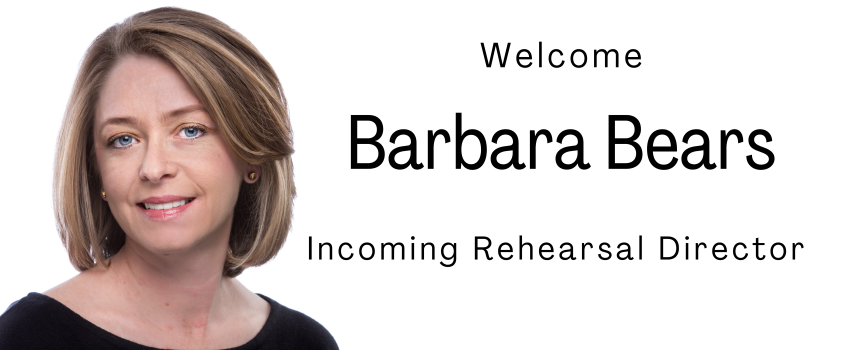
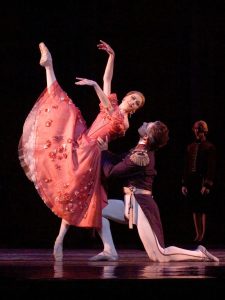 Pittsburgh Ballet Theatre (PBT) has named Barbara Bears as the organization’s new rehearsal director. She will be taking over the role formerly held by Marianna Tcherkassky until her retirement in June. Bears was previously a dancer with the Houston Ballet for more than 20 years, including as a principal dancer for 15 of those years. After her retirement, she served as a teacher and coach for Houston Ballet, Houston Ballet 2, and the Ben Stevenson Academy before joining the professional company’s artistic staff as a ballet master in 2016. Barbara answered a few questions for us to help Pittsburgh audiences get acquainted with her.
Pittsburgh Ballet Theatre (PBT) has named Barbara Bears as the organization’s new rehearsal director. She will be taking over the role formerly held by Marianna Tcherkassky until her retirement in June. Bears was previously a dancer with the Houston Ballet for more than 20 years, including as a principal dancer for 15 of those years. After her retirement, she served as a teacher and coach for Houston Ballet, Houston Ballet 2, and the Ben Stevenson Academy before joining the professional company’s artistic staff as a ballet master in 2016. Barbara answered a few questions for us to help Pittsburgh audiences get acquainted with her.
What was the first ballet you ever danced in onstage?
The first ballet I danced as a professional was George Balanchine’s The Four Temperaments. It was my first year with Houston Ballet and the first rep of the
season. I was an understudy for the 3rd Theme, but due to a last-minute injury, danced the role opening night. I remember being so nervous and excited at the same time. It is definitely a special memory from my early career as a professional.
What are you most excited to do in Pittsburgh? 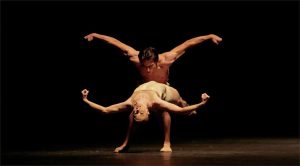
The Warhol Museum is a must! I also plan to carve out a day and see Frank Lloyd Wright’s Falling Water.
What is your guilty pleasure?
Sweets! I love anything with dark chocolate!
What do you like to do in your spare time?
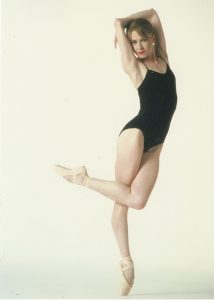 Being a full-time assistant to my French Bulldog, Po. Kidding aside, I enjoy HIIT training, watching movies, baking, spending time with my family, and long walks with Po.
Being a full-time assistant to my French Bulldog, Po. Kidding aside, I enjoy HIIT training, watching movies, baking, spending time with my family, and long walks with Po.
Where was your favorite vacation spot?
The Caribbean – I’ve been a certified scuba diver for over 30 years.
What’s the most memorable day you’ve ever had and why?
The birth of my son. Being a Mom is the greatest gift.
What was the last song you had stuck in your head?
Typically whatever ballet I happen to working on.
What are you most looking forward to this season at PBT?
Wow, way too many to list. I’m most excited about working with Adam and the artists of PBT. I’m so excited to be part of this new chapter in PBT’s history. I believe exciting times are ahead.
